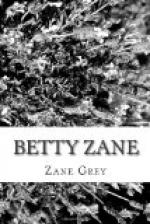The trail led up the hill and far into the woods. Never in doubt the hunter kept on his course; like a shadow he passed from tree to tree and from bush to bush; silently, cautiously, but rapidly he followed the tracks of the Indians. When he had penetrated the dark backwoods of the Black Forest tangled underbrush, windfalls and gullies crossed his path and rendered fast trailing impossible. Before these almost impassible barriers he stopped and peered on all sides, studying the lay of the land, the deadfalls, the gorges, and all the time keeping in mind the probable route of the redskins. Then he turned aside to avoid the roughest travelling. Sometimes these detours were only a few hundred feet long; often they were miles; but nearly always he struck the trail again. This almost superhuman knowledge of the Indian’s ways of traversing the forest, which probably no man could have possessed without giving his life to the hunting of Indians, was the one feature of Wetzel’s woodcraft which placed him so far above other hunters, and made him so dreaded by the savages.
Descending a knoll he entered a glade where the trees grew farther apart and the underbrush was only knee high. The black soil showed that the tract of land had been burned over. On the banks of a babbling brook which wound its way through this open space, the hunter found tracks which brought an exclamation from him. Clearly defined in the soft earth was the impress of a white man’s moccasin. The footprints of an Indian toe inward. Those of a white man are just the opposite. A little farther on Wetzel came to a slight crushing of the moss, where he concluded some heavy body had fallen. As he had seen the tracks of a buck and doe all the way down the brook he thought it probable one of them had been shot by the white hunter. He found a pool of blood surrounded by moccasin prints; and from that spot the trail led straight toward the west, showing that for some reason the Indians had changed their direction.
This new move puzzled the hunter, and he leaned against the trunk of a tree, while he revolved in his mind the reasons for this abrupt departure—for such he believed it. The trail he had followed for miles was the devious trail of hunting Indians, stealing slowly and stealthily along watching for their prey, whether it be man or beast. The trail toward the west was straight as the crow flies; the moccasin prints that indented the soil were wide apart, and to an inexperienced eye looked like the track of one Indian. To Wetzel this indicated that the Indians had all stepped in the tracks of a leader.
As was usually his way, Wetzel decided quickly. He had calculated that there were eight Indians in all, not counting the chief whom he had shot. This party of Indians had either killed or captured the white man who had been hunting. Wetzel believed that a part of the Indians would push on with all possible speed, leaving some of their number to ambush the trail or double back on it to see if they were pursued.




